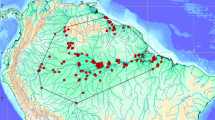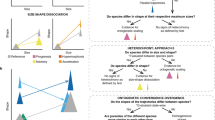Abstract
The tiger salamander,Ambystoma tigrinum, is a geographically widespread, morphologically variable, polytipic species. It is among the most variable species of salamanders in morphology and life history with two larval morphs (typical and cannibal) and three adult morphs (metamorphosed, typical branchiate, cannibal branchiate) that vary in frequency between subspecies and between populations within subspecies. We report morphometric evidence suggesting that branchiate cannibals arose through intraspecific change in the onset or timing of development resulting in the wider head and hypertrophied tooth-bearing skull bones characteristic of this phenotype. We also quantified bilateral symmetry of gill raker counts and abnormalities, then evaluated fluctuating asymmetry as a measure of the developmental stability of each morph. There was a significant interaction between fluctuating asymmetry of developmental abnormalities in cannibals and typicals and the locality where they were collected, suggesting that relative stability of each phenotype could vary among populations. While altered timing of developmental events appears to have a role in the evolution and maintenance of morphs, novel phenotypes persist only under favorable ecological conditions. Predictability of the aquatic habitat, genetic variation, kinship, body size, intraspecific competition and predation all affect expression and survival of the morphs inA. tigrinum. This taxon provides an excellent model for understanding the diversity and complexity of developmental and ecological variables controlling the evolution and maintenance of novel phenotypes.
Similar content being viewed by others
References
Alberch, P., S. J. Gould, G. F. Oster & D. B. Wake, 1979. Size and shape in ontogeny and phylogeny. Paleobiology 5: 296–318.
Alexander, R. D. & R. S. Bigelow, 1960. Allochronic speciation in field crickets and a new species,Acheta veletis. Evolution 14: 334–346.
Baird, D., 1965. Paleozoic lepospondyl amphibians. Amer. Zool. 5: 287–294.
Begun, D. J. & J. P. Collins, 1992. Biochemical plasticity in the Arizona tiger salamander (Ambystoma tigrinum nebulosum). J. Heredity 83: 224–227.
Berna, H., 1990. Ecology and life history of the tiger salamander,Ambystoma tigrinum nebulosum Hallowell, on the Kaibab Plateau. M.S. thesis, Arizona State University.
Bolt, J. R., 1979.Amphibamus grandiceps as a juvenile dissorophid: evidence and implications, pp. 529–563 in Mazon Creek Fossils, edited by M. H. Nitecki. Academic Pr., NY.
Bookstein, F. L., B. Chernoff, R. L. Elder, J. M. Humphries, G. R. Smith & R. E. Strauss, 1985. Morphometrics in Evolutionary Biology. Spec. Publ. no. 15. Acad. Nat. Sci. Phil.
Brandon, R. A., 1972. Hybridization between the Mexican salamandersAmbystoma dumerilii andAmbystoma mexicanum under laboratory conditions. Herpetologica 28: 199–207.
Brandon, R. A., 1977. Interspecific hybridization among Mexican and United States salamanders of the genusAmbystoma under laboratory conditions. Herpetologica 33: 133–152.
Burnaby, T. P., 1966. Growth-invariant discriminant functions and generalized distances. Biometrics 22: 96–110.
Cattell, R. B., 1966. The Scree Test for the number of factors. Multivar. Behav. Res. 1: 245–276.
Collins, J. P., 1981. Distribution, habitats and life history variation in the tiger salamander,Ambystoma tigrinum, in east-central and southeast Arizona. Copeia 1981: 666–675.
Collins, J. P. & J. R. Holomuzki, 1984. Intraspecific variation in diet within and between trophic morphs in larval tiger salamanders (Ambystoma tigrinum nebulosum). Canadian Journal of Zoology 62: 168–174.
Collins, J. P. & J. E. Cheek, 1983. Effect of food and density on development of typical and cannibalistic salamander larvae inAmbystoma tigrinum nebulosum. Amer. Zool. 23: 77–84.
Crump, M. L., 1992. Cannibalism in amphibians, pp. 256–276 in Cannibalism: Ecology and Evolution among Diverse Taxa, edited by M. A. Elgar and B. J. Crespi. Oxford University Press, Oxford, UK.
DeMar, R., 1968. The Permian labyrinthodont amphibianDissorophus multicinctus, and adaptations and phylogeny of the family Dissorophidae. J. Paleontology 42: 1210–1242.
DeQueiroz, K., 1985. The ontogenetic method for determining character polarity and its relevance to phylogenetic systematics. Syst. Zool. 34: 280–299.
Dobzhansky, Th., 1937. Genetics and the Origin of Species. Columbia Univ. Pr., NY.
Duellman, W. E. & L. Treub, 1986. Biology of Amphibians. McGraw-Hill, NY.
Edwards, J. L., 1976. Spinal nerves and their bearing on salamander phylogeny. J. Morph. 148: 305–328.
Eldredge, N. & S. J. Gould, 1972. Punctuated equilibria: an alternative to phyletic gradualism, pp. 82–115 in Models in Paleobiology, edited by T. J. M. Schopf. Freeman, SF.
Emerson, S. B., 1986. Heterochrony and frogs: the relationship of a life history trait to morphological form. Amer. Natur. 127: 167–183.
Estes, R., 1981. Teil 2. Gymnophiona, Caudata. Handbuch der Paläoherpetologie. Gustav Fischer Verlag, Stuttgart.
Fink, W. L., 1982. The conceptual relationship between ontogeny and phylogeny. Paleobiology 8: 254–264.
Ford, E. B., 1965. Genetic Polymorphism. M.I.T. Pr., Cambridge.
Gauch, H. G., Jr., 1982. Noise reduction by eigenvector ordination. Ecology 63: 1643–1649.
Gehlbach, F. R., 1965. The herpetology of the Zuni Mountains region, northwestern New Mexico. Proc. U. S. Nat. Mus. 116: 243–332.
Gehlbach, F. R., 1967.Ambystoma tigrinum (Green). Tiger salamander. Catalogue of American Amphibians and Reptiles: 52.1–52.4.
Gould, S. J., 1977. Ontogeny and Phylogeny. Belknap Pr., Cambridge.
Hecht, M. K., 1957. A case of parallel evolution in salamanders. Proc. Zool. Soc., Calcutta, Mookerjee Memor. 1957: 283–292.
Holomuzki, J. R. & J. P. Collins, 1987. Trophic dynamics of a top predator,Ambystoma tigrinum nebulosum (Caudata: Ambystomatidae), in a lentic community. Copeia 1987: 949–957.
Humphries, J. M., F. L. Bookstein, B. Chernoff, G. R. Smith, R. L. Elder & S. G. Poss, 1981. Multivariate discrimination by shape in relation to size. Syst. Zool. 30: 291–308.
Johnson, R. A. & D. W. Wichern, 1982. Applied Multivariate Statistical Analysis. Prentice-Hall, Englewood Cliffs, NJ.
Jolicoeur, P., 1963. The multivariate generalization of the allometry equation. Biometrics 19: 497–499.
Jones, T. R., J. P. Collins, T. D. Kocher & J. B. Mitton, 1988. Systematic status and distribution ofAmbystoma tigrinum stebbinsi Lowe. Copeia: 621–635.
Kirkpatrick, M., 1982. Quantum evolution and punctuated equilibria in continuous genetic characters. Amer. Natur. 119: 833–848.
Kluge, A., 1984. The relevance of parsimony to phylogenetic inference, pp. 24–38 in Cladistics: Perspectives on the Reconstruction of Evolutionary History, edited by T. Duncan and T. Stuessy. Columbia Univ. Pr., NY.
Kluge, A., 1985. Ontogeny and phylogenetic systematics. Cladistics 1: 13–27.
Kluge, A. & R. E. Strauss, 1985. Ontogeny and systematics. Ann. Rev. Ecol. Syst. 16: 247–268.
Knerer, G. & C. E. Atwood, 1973. Diprionid sawflies: polymorphism and speciation. Science 179: 1090–1099.
Lannoo, M. & M. Bachmann, 1984. Aspects of cannibalistic morphs in a population ofA. t. tigrinum larvae. Amer. Midl. Natur. 122: 103–109.
Lerner, I. M., 1954. Genetic Homeostasis. Dover, N.Y.
Loeb, M. L. G., J. P. Collins & T. J. Maret, 1993, in press. The role of prey in controlling expression of a trophic polymorphism inAmbystoma tigrinum nebulosum. Functional Ecology: 29 pp. ms.
Mather, I., 1955. Polymorphism as an outcome of disruptive selection. Evolution 9: 52–61.
Mayr, E., 1942. Systematics and the Origin of Species. Columbia Univ. Pr., NY.
Meyer, A., 1987. Phenotypic plasticity and heterochrony inCichlasoma managuense (Pisces, Cichlidae) and their implications for speciation in cichlid fishes. Evolution 41: 1357–1369.
Milligan, B. G., 1986. Punctuated evolution induced by ecological change. Amer. Natur. 127: 522–532.
Minckley, W. L., D. A. Hendrickson & C. E. Bond, 1986. Geography of western North American freshwater fishes: description and relationships to intracontinental tectonism, pp. 519–613 in The Zoogeography of North American Freshwater Fishes, edited by C. H. Hocutt & E. O. Wiley. Wiley, NY.
Nelson, G., 1978. Ontogeny, phylogeny, paleontology, and the biogenetic law. Syst. Zool. 27: 324–345.
Ohlandt, G., 1992. Microgeographic variation in life history ofAmbystoma tigrinum nebulosum in Arizona. M.S. thesis, Arizona State University.
Palmer, A. R. & C. Strobeck, 1986. Fluctuating asymmetry: measurement, analysis, patterns. Ann. Rev. Ecol. Syst. 17: 391–421.
Pedersen, S. C., 1991. Dental morphology of the cannibal morph in the tiger salamander,Ambystoma tigrinum. Amphibia-Reptilia 12: 1–14.
Pfennig, D. W., M. L. G. Loeb & J. P. Collins, 1991. Pathogens as a factor limiting the spread of cannibalism in tiger salamanders. Oecologia 88: 161–166.
Pfennig, D. W. & J. P. Collins, 1993. Kinship affects morphogenesis in cannibalistic salamanders. Nature 362: 836–838.
Pfennig, D. W., P. W. Sherman & J. P. Collins, 1993, in press. Kinship and cannibalism in polyphenic salamanders. Behavioral Ecology: 43 pp. ms.
Pierce, B. A., J. B. Mitton, L. Jacobson & F. L. Rose, 1983. Head shape and size in cannibal and noncannibal morphs of the tiger salamander from west Texas. Copeia 1983: 1006–1012.
Pimentel, R. A., 1979. Morphometrics. Kendall/Hunt, Dubuque.
Powers, J. H., 1903. The causes of acceleration and retardation in the metamorphosis ofAmbystoma tigrinum: A preliminary report. Amer. Natur. 37: 385–410.
Powers, J. H., 1907. Morphological variation and its causes inAmbystoma tigrinum. Stud. Univ. Nebraska 7: 197–274.
Regal, P. J., 1966. Feeding specializations and the classification of terrestrial salamanders. Evolution 20: 392–407.
Reilly, S. M., G. V. Lauder & J. P. Collins, 1992. Performance consequences of a trophic polymorphism: feeding behavior in typical and cannibal phenotypes ofAmbystoma tigrinum. Copeia 1992: 672–679.
Reyment, R. A., R. E. Blackith & N. A. Campbell, 1984. Multivariate Morphometrics.2nd ed. Acad. Pr., NY.
Rohlf, F. J. & F. L. Bookstein, 1987. A comment on shearing as a method for ‘size correction’. Syst. Zool. 36: 356–367.
Rosenzweig, M. L., 1978. Competitive speciation. Biol. J. Linnean Soc. 10: 275–289.
Roughgarden, J., 1972. Evolution of niche width. Amer. Natur. 106: 683–713.
Sage, R. D. & R. K. Selander, 1975. Trophic radiation through polymorphism in cichlid fishes. Proc. Nat. Acad. Sci. USA 72: 4660–4673.
Seger, J., 1985. Intraspecific resource competition as a cause of sympatric speciation, pp. 43–53 in Essays in Honor of John Maynard Smith, edited by P. J. Greenwood, P. H. Harvey & M. Slatkin. Cambridge Univ. Pr., Cambridge.
Shaffer, H. B., 1984a. Evolution in a paedomorphic lineage. I. An electrophoretic analysis of the Mexican ambystomatid salamanders. Evolution 38: 1194–1206.
Shaffer, H. B., 1984b. Evolution in a paedomorphic lineage. II. Allometry and form in the Mexican ambystomatid salamanders. Evolution 38: 1207–1218.
Sokal, R. R. & F. J. Rohlf, 1981. Biometry, 2nd ed. Freeman, SF.
Somers, K. M., 1986. Multivariate allometry and removal of size with principal components analysis. Syst. Zool. 35: 359–368.
Soulé, M. E. & J. Cuzin-Roudy, 1982. Allometric variation. 2. Developmental instability of extreme phenotypes. Amer. Natur. 120: 765–786.
Stanely, S. M., 1979. Macroevolution. Freeman, SF.
Stevens, P. F., 1980. Evolutionary polarity of character states. Ann. Rev. Ecol. Syst. 11: 333–358.
Szarski, H., 1957. The origin of the larva and metamorphosis in Amphibia. Amer. Natur. 91: 281–301.
Szarski, H., 1962. The origin of the Amphibia. Q. Rev. Biol. 37: 189–241.
Thoday, J. M., 1953. Homeostasis in a selection experiment. Heredity 12: 401–415.
Tihen, J., 1958. Comments on the osteology and phylogeny of ambystomatid salamanders. Bull. Florida State Mus. 3: 1–51.
Vrijenhoek, R. C., 1984. Ecological differentiation among clones: the frozen niche variation model, pp. 217–231 in Population Biology and Evolution, edited by K. Wöhrmann & V. Loescheke. Springer-Verlag, Berlin.
Waddington, C. H., 1957. The Strategy of the Genes. MacMillan, NY.
West-Eberhard, M. J., 1986. Alternative adaptations, speciation, and phylogeny (a review). Proc. Nat. Acad. Sci. USA 83: 1388–1392.
White, M. J. D., 1978. Models of Speciation. Freeman, SF.
Wiley, E. O., 1980. Phylogenetic systematics and vicariance biogeography. Syst. Bot. 5: 194–220.
Wiley, E. O., 1981. Phylogenetics: The Theory and Practice of Phylogenetic Systematics. Wiley, NY.
Wright, S. W., 1968. Evolution and the Genetics of Populations. Vol 1. Genetic and Biometric Foundations. Univ. Chicago Pr., Chicago.
Wright, S. W., 1978. Evolution and the Genetics of Populations. Vol 4. Variability within and among Natural Populations. Univ. Chicago Pr., Chicago.
Wright, S. W., 1982. Character change, speciation, and the higher taxa. Evolution 36: 427–443.
Author information
Authors and Affiliations
Rights and permissions
About this article
Cite this article
Collins, J.P., Zerba, K.E. & Sredl, M.J. Shaping intraspecific variation: Development, ecology and the evolution of morphology and life history variation in tiger salamanders. Genetica 89, 167–183 (1993). https://doi.org/10.1007/BF02424512
Accepted:
Issue Date:
DOI: https://doi.org/10.1007/BF02424512




